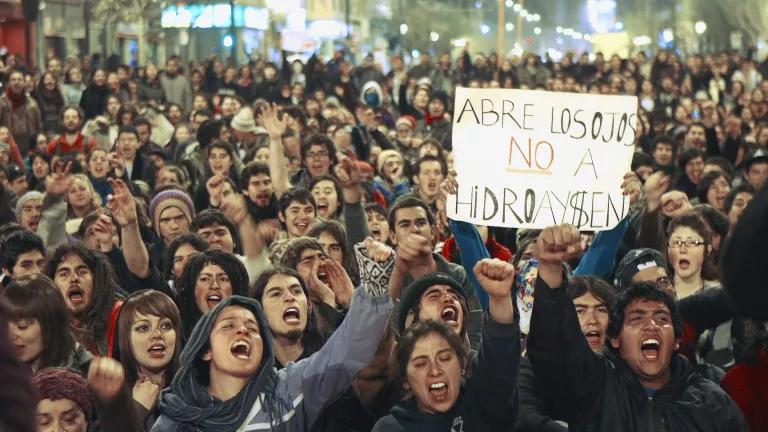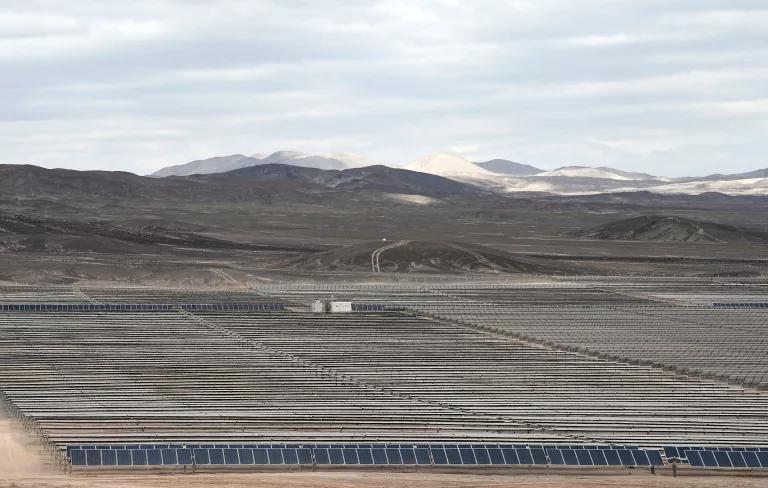The Rise of Chile’s River Protectors
For decades, NRDC has worked alongside Chileans who are fighting to save Patagonia’s wildest rivers from being yoked by massive hydroelectric dams.

Protesters rallying after Chilean environmental regulators approved the HidroAysén hydroelectric mega-project, May 2011
One of Amanda Maxwell’s most memorable moments in her nine years working on environmental issues in Chile happened on the streets of Santiago in June 2011. The Chilean government had recently approved a 2007 proposal for HidroAysén, a $10 billion hydroelectric project that would construct five mega-dams on two of Patagonia’s wildest and most remote rivers, the Baker and the Pascua. In response, tens of thousands of people had taken to the streets.
“I’d been to a couple of protests in Washington, D.C., but this was on another scale,” Maxwell says. “It was one of the most remarkable things I have ever experienced. It was just so incredible to be part of this massive wave of people marching down the main avenue to the presidential palace.”
Maxwell, director of NRDC’s Latin America Project, characterizes those protests as a turning point for the protection of Chile’s rivers. HidroAysén’s approval wasn’t a huge surprise—the government supports hydroelectric power development—but it served as a galvanizing moment for the Chilean people, who overwhelmingly did not want to see the project move forward.
And for good reason. Such large hydroelectric projects wreak significant environmental and social damage. They degrade water quality and disrupt water and sediment flow, which can harm biodiversity and alter fish migrations; they release toxic methane and other greenhouse gases into the atmosphere; and they displace local communities whose livelihoods depend on healthy rivers in myriad ways. What’s more, this particular 2,750-megawatt project would require the construction of about 1,000 miles of transmission lines around active volcanoes, over fault lines, and through communities, so that the generated electricity could reach northern Chile and be used, in part, to power the copper mines there. Chileans also feared HidroAysén would open the door for the construction of additional large hydroelectric projects and more industrial development in the area.
Chilean Patagonia is one of the last unspoiled expanses left on the planet. Thriving among its lush fjords, dense rainforests, and snow-capped glaciers is a diverse array of wildlife—including one of the last healthy populations of the huemul, an endangered Andean deer and a national symbol of Chile. It’s also ancestral territory of various indigenous communities, including the Mapuche, the largest indigenous group in the country. And running throughout the remote region are rushing, life-giving turquoise rivers—rivers that would be forever altered by the introduction of hydroelectric dams.
The Opposition Gathers Steam
Soon after HidroAysén’s approval, the Patagonia Defense Council, a coalition NRDC had joined in 2008 to oppose the dams, launched a protracted legal battle to appeal the decision. NRDC helped provide legal analysis. Building on the momentum of the public outcry against the project, the coalition intensified its efforts toto raise awareness and amplify the voices of scientists and high-profile Chilean artists, actors, and musicians who joined the resistance.

“Over time, it became more and more politically acceptable in Chile to oppose the dams,” Maxwell says. The huge shift in public opinion played a significant role: In 2007, the year HidroAysén was proposed, only 38 percent of Chileans opposed it; by 2011, 74 percent did. Local mayors cited the tremendous environmental and economic harm the industrialization of the landscape would cause to their municipalities—including the loss of ecotourism revenue. One presidential hopeful indicated in 2013 that HidroAysén was “dead,” a sentiment that soon spread; Maxwell notes that after NRDC’s Chilean partners made the dams a campaign issue in that year’s election, all but one major candidate committed to canceling the HidroAysén project if elected.
Michelle Bachelet, who took office (again) in March 2014, kept that promise. On June 10, 2014, the Chilean government overturned HidroAysén’s environmental approvals, a watershed moment for the country’s clean energy development. “For decades, whenever an energy company wanted to build something, they’d just do it,” Maxwell says, noting that the public outcry against HidroAysén was only the second time such a thing had happened at the national scale in Chile. (NRDC was also there the first time, working with Chileans to fight a hydroelectric project on the Bíobío River. Unfortunately, it gained approval in 1992 and, despite years of pushback, began operating in 2004. Among its many impacts on the land, it devastated an indigenous Pehuenche community, which was displaced by dam construction back in 2004 and whose members are still waiting for full reparations.)
A Renewables Revolution
The decision to cancel HidroAysén’s approval also validated the years NRDC spent making the case for the adoption of alternatives to large hydroelectric dams. In particular, climate advocates focused on nonconventional renewables—that is, renewable energy options that don’t include large hydro—and energy efficiency. Maxwell and partners had begun with the basics, focusing on convincing the right people that Chile actually had the potential for renewable energy. Indeed, the Atacama Desert in the country’s north is among the driest and sunniest places on earth, making it an ideal spot for solar power generation as well as wind farms, and the country’s 2,653-mile coastline is also rife with wind potential. Countering the dam supporters’ claim that other renewables are too expensive, a 2013 NRDC report clearly showed such alternative energy sources could actually add to Chile’s economy.

The country has not overlooked this potential, and today its clean energy industries are booming, part of the legacy of former President Bachelet, who received the United Nations Champion of the Earth award last December. Chile is currently producing 18 percent of its energy from renewable sources and is on track to far surpass its 2013 commitment to reach 20 percent by 2025. And most recently, President Sebastian Piñera, who took office in March, has called for an all-renewable electricity grid (including large hydro) by 2040.
Meanwhile, the cancellation of HidroAysén and the focus on a clean energy future have helped give birth to a new generation of young river protectors—people who are not only fighting dam proposals as they arise, but also working to protect entire watersheds and promote long-term clean energy solutions (such as wind, solar, and geothermal operations).
Red por los Ríos Libres, or the Network for Free-Flowing Rivers, meets two or three times a year to share stories, discuss milestones and lessons, and strategize about the future. At the fifth summit, which took place in March, the group launched the Propuesta Ciudadana de Política Energética (Citizens’ Energy Policy Proposal), a formal, grassroots vision supporting the expansion of sustainable energy projects in Patagonia’s Aysén region. The activists’ motive is simple, explains James Blair, an international campaign advocate at NRDC who works closely with the Chilean activists. They believe that “Patagonia is one of the last great expanses on earth that should be preserved—and allowed to develop according to the desires of local communities,” he says. “They don’t want [the rivers] to become sacrifice zones for the sake of producing energy for distant urban centers like Santiago.”
Despite all the progress, the threat of hydroelectric projects still looms large: Seven significant initiatives are currently under development in Chile. The activists are closely watching the moves of pro-hydro President Piñera. (As Blair notes, the press has already reported on Piñera’s extensive network of former business partners who are interested in reviving defeated hydroelectric energy proposals.) So while some communities are breathing sighs of relief after beating back projects, others are still on the front lines, battling to protect their livelihoods. “To Chile’s growing network of activists, rivers are the lifeblood of their territory, and the fight for water rights has only just begun,” Blair says.
This NRDC.org story is available for online republication by news media outlets or nonprofits under these conditions: The writer(s) must be credited with a byline; you must note prominently that the story was originally published by NRDC.org and link to the original; the story cannot be edited (beyond simple things such as grammar); you can’t resell the story in any form or grant republishing rights to other outlets; you can’t republish our material wholesale or automatically—you need to select stories individually; you can’t republish the photos or graphics on our site without specific permission; you should drop us a note to let us know when you’ve used one of our stories.

Lithium Mining Is Leaving Chile’s Indigenous Communities High and Dry (Literally)
A Fearless Defender for Our Future
This Is How We Stand Up to Trump